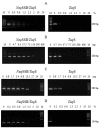Fusion of Taq DNA polymerase with single-stranded DNA binding-like protein of Nanoarchaeum equitans-Expression and characterization
- PMID: 28863186
- PMCID: PMC5581180
- DOI: 10.1371/journal.pone.0184162
Fusion of Taq DNA polymerase with single-stranded DNA binding-like protein of Nanoarchaeum equitans-Expression and characterization
Abstract
DNA polymerases are present in all organisms and are important enzymes that synthesise DNA molecules. They are used in various fields of science, predominantly as essential components for in vitro DNA syntheses, known as PCR. Modern diagnostics, molecular biology and genetic engineering need DNA polymerases which demonstrate improved performance. This study was aimed at obtaining a new NeqSSB-TaqS fusion DNA polymerase from the Taq DNA Stoffel domain and a single-stranded DNA binding-like protein of Nanoarchaeum equitans in order to significantly improve the properties of DNA polymerase. The DNA coding sequence of Taq Stoffel DNA polymerase and the nonspecific DNA-binding protein of Nanoarchaeum equitans (NeqSSB-like protein) were fused. A novel recombinant gene was obtained which was cloned into the pET-30 Ek/LIC vector and introduced into E. coli for expression. The recombinant enzyme was purified and its enzymatic properties including DNA polymerase activity, PCR amplification rate, thermostability, processivity and resistance to inhibitors, were tested. The yield of the target protein reached approximately 18 mg/l after 24 h of the IPTG induction. The specific activity of the polymerase was 2200 U/mg. The recombinant NeqSSB-TaqS exhibited a much higher extension rate (1000 bp template in 20 s), processivity (19 nt), thermostability (half-life 35 min at 95°C) and higher tolerance to PCR inhibitors (0.3-1.25% of whole blood, 0.84-13.5 μg of lactoferrin and 4.7-150 ng of heparin) than Taq Stoffel DNA polymerase. Furthermore, our studies show that NeqSSB-TaqS DNA polymerase has a high level of flexibility in relation to Mg2+ ions (from 1 to 5 mM) and KCl or (NH4)2SO4 salts (more than 60 mM and 40 mM, respectively). Using NeqSSB-TaqS DNA polymerase instead of the Taq DNA polymerase could be a better choice in many PCR applications.
Conflict of interest statement
Figures








Similar articles
-
A Fusion of Taq DNA Polymerase with the CL7 Protein from Escherichia coli Remarkably Improves DNA Amplification.Molecules. 2024 Mar 4;29(5):1145. doi: 10.3390/molecules29051145. Molecules. 2024. PMID: 38474657 Free PMC article.
-
Characterization of a Single-Stranded DNA-Binding-Like Protein from Nanoarchaeum equitans--A Nucleic Acid Binding Protein with Broad Substrate Specificity.PLoS One. 2015 May 14;10(5):e0126563. doi: 10.1371/journal.pone.0126563. eCollection 2015. PLoS One. 2015. PMID: 25973760 Free PMC article.
-
A novel approach for high-level expression and purification of GST-fused highly thermostable Taq DNA polymerase in Escherichia coli.Arch Microbiol. 2020 Aug;202(6):1449-1458. doi: 10.1007/s00203-020-01860-9. Epub 2020 Mar 18. Arch Microbiol. 2020. PMID: 32189018
-
[Polymerase chain reaction, cold probes and clinical diagnosis].Sante. 1994 Jan-Feb;4(1):43-52. Sante. 1994. PMID: 7909267 Review. French.
-
[Comparative Analysis of Family A DNA-Polymerases as a Searching Tool for Enzymes with New Properties].Mol Biol (Mosk). 2023 Mar-Apr;57(2):185-196. Mol Biol (Mosk). 2023. PMID: 37000648 Review. Russian.
Cited by
-
DNA Polymerases for Whole Genome Amplification: Considerations and Future Directions.Int J Mol Sci. 2023 May 26;24(11):9331. doi: 10.3390/ijms24119331. Int J Mol Sci. 2023. PMID: 37298280 Free PMC article. Review.
-
Strategies and procedures to generate chimeric DNA polymerases for improved applications.Appl Microbiol Biotechnol. 2024 Aug 21;108(1):445. doi: 10.1007/s00253-024-13276-2. Appl Microbiol Biotechnol. 2024. PMID: 39167106 Free PMC article. Review.
-
An enhanced activity and thermostability of chimeric Bst DNA polymerase for isothermal amplification applications.Appl Microbiol Biotechnol. 2023 Nov;107(21):6527-6540. doi: 10.1007/s00253-023-12751-6. Epub 2023 Sep 6. Appl Microbiol Biotechnol. 2023. PMID: 37672070
-
Engineered viral DNA polymerase with enhanced DNA amplification capacity: a proof-of-concept of isothermal amplification of damaged DNA.Sci Rep. 2020 Sep 14;10(1):15046. doi: 10.1038/s41598-020-71773-6. Sci Rep. 2020. PMID: 32929102 Free PMC article.
-
One-Enzyme Reverse Transcription qPCR Using Taq DNA Polymerase.Biochemistry. 2020 Dec 15;59(49):4638-4645. doi: 10.1021/acs.biochem.0c00778. Epub 2020 Dec 4. Biochemistry. 2020. PMID: 33275410 Free PMC article.
References
-
- Kaledin AS, Sliusarenko AG, Gorodetskiĭ SI. Isolation and properties of DNA polymerase from extreme thermophylic bacteria Thermus aquaticus YT-1. Biokhimiia. 1980; 45:644–651. - PubMed
-
- Saiki RK, Gelfand DH, Stoffel S, Scharf SJ, Higuchi R, Horn GT, et al. Primer-directed enzymatic amplification of DNA with a thermostable DNA polymerase. Science. 1988; 239:487–491. - PubMed
-
- Lawyer FC, Stoffel S, Saiki RK, Chang SY, Landre PA, Abramson RD, et al. High-level expression, purification, and enzymatic characterization of full-length Thermus aquaticus DNA polymerase and a truncated form deficient in 5′ to 3′ exonuclease activity. PCR Methods Appl. 1993; 2:275–287. - PubMed
-
- Arezi B, Xing W, Sorge JA, Hogrefe HH. Amplification efficiency of thermostable DNA polymerases. Anal Biochem. 2003; 321:226–235. - PubMed
MeSH terms
Substances
LinkOut - more resources
Full Text Sources
Other Literature Sources
Research Materials

